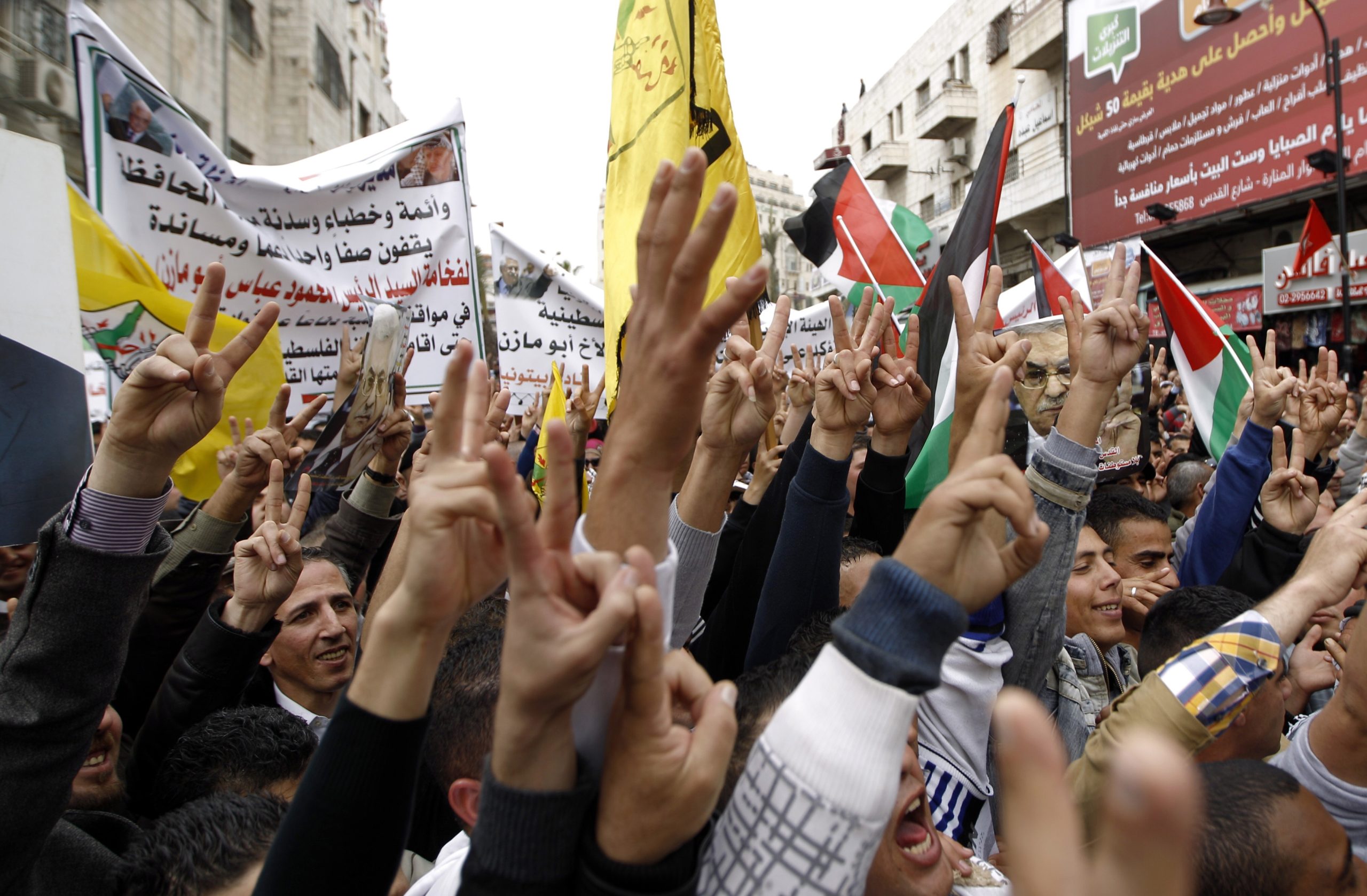Publications
INSS Insight No. 1907, November 12, 2024
A comparative analysis of four polls, conducted with the requisite caution due to methodological limitations, reveals fundamental differences in the findings in relation to similar questions asked across the different polls. This analysis especially highlights the dialectic expressed in the criticism of Hamas and the dissatisfaction with its functioning; the decline in the popularity of Yahya Sinwar (before he was killed) and Hamas alongside increased support for Hamas compared to Fatah; and the support for continuing the armed struggle led by Hamas. Palestinian society in the Gaza Strip is more critical of Hamas than Palestinians in the West Bank and Jerusalem and views the Palestinian Authority, Fatah, and Abu Mazen more positively. This may lay the groundwork for eliminating Hamas’s regime in the Gaza Strip and gaining support for an alternative civilian regime to Hamas.
However, the findings of the polls indicate a solid psychological foundation of support for the armed struggle and broad opposition to a two-state solution. Mirror images regarding the level of support for a two-state solution can also be found in the Israeli public. This suggests that the validity of the two-state paradigm has declined at present, and it is doubtful whether it will become valid again in the foreseeable future unless a fundamental change occurs in the conditions and moods of both populations.
From July to September 2024, several public opinion polls were conducted among Palestinians in the West Bank, East Jerusalem, and the Gaza Strip. The findings from the different polls regarding similar issues, formulated in different ways, lack coherence. Nonetheless, even considering the impact of the war and the fact that polls generally represent views at a specific point in time, the responses allow us—with the necessary caution—to identify several insights and discern trends. This article will present the findings of the polls and initial insights from their comparative analysis. In some cases, the findings will be compared to those of previous polls.
The polls selected:
- PCPSR (Palestinian Center for Public Survey and Research), “Press Release: Public Opinion Poll No. 93 ,” conducted in September by Dr. Khalil Shikaki
- AWRAD (Arab World for Research and Development), Public Opinion Poll—Gaza Strip, September 8, 2024 (conducted in August 2024).
- Independent Opinion Research Strategy, by Dr. Dahlia Scheindlin and Dr. Khalil Shikaki of the PCPSR
- Zogby Research Services, “Palestine 2024,” conducted in July and August 2024 for the Tony Blair Institute.
In some of the poll findings, a positive correlation was identified for similar questions; however, in most cases, no correlations were found between the polls, and contradictions were even noted. Moreover, the September PCPSR poll, headed by Dr. Khalil Shikaki, asked questions identical to those in previous quarterly polls. Since October 2023, some of the findings have been extremely volatile, particularly those concerning the level of support for Hamas’s October 7 attack. The situation becomes even more complicated when we compare the findings of different polls regarding similar questions.
Methodological Aspects
Some polls were administered through face-to-face interviews (for example, the PCPSR poll), while others were conducted by phone. In both methods, especially with the Palestinian public in the Gaza Strip, an effort was made to produce a representative sample of the population, although most of those sampled are currently residing in humanitarian shelters. Given the halo effect of the ongoing war, deviations in responses are possible. Thus, it is important to approach the findings with caution, particularly due to the significant differences between them.
For the sake of comparative analysis, the topics surveyed in each of the four polls that used similarly worded questions were mapped. Methodologically, it is challenging to compare responses to questions that were not identically worded; however, acknowledging this limitation, the comparisons still hold research value, as they can provide insights into mood trends within Palestinian society. It is crucial to qualify the conclusions; therefore, efforts must be made to validate them with additional findings, whenever available.
In this context, the Washington Institute poll, conducted in August 2024 in cooperation with the PCPO (Palestinian Center for Public Opinion) led by Nabil Kukali, is significant. This poll examined the views of the Palestinian public on questions that partially overlap with those addressed in Dr. Shikaki’s most recent polls, from various regions of the West Bank (north, central, and south). The poll findings indicate notable differences between the results from different regions, particularly reflected in the more radical and militant views among respondents from the southern and northern regions of the West Bank. These findings add to the methodological complexity involved in interpreting all poll results, especially during wartime. In their presentations of the findings, the surveyors in the different polls do not distinguish between the various regions of the West Bank or in comparisons of the poll results.
The Findings and Comparison among the Polls
The poll findings were examined and compared, focusing on five prominent topics:
- The position on Hamas’s October 7 attack
- Assessments and preferences regarding the future regime in the Gaza Strip
- The level of support for continuing the armed struggle
- The level of support for a two-state or one-state solution
- The level of support for Hamas, Fatah, and the president of the Palestinian Authority (PA), Mahmoud Abbas.
Hamas’s October 7 Attack
The most significant poll in this context is Khalil Shikaki’s quarterly poll (September 2024), which allows for comparison with previous quarterly polls regarding the same question (see Figure 1). The findings indicate a decrease in the percentage of support for Hamas’s attack, or, to use the wording of the question, was the decision to attack Israel correct or incorrect. In September, 54% of the Palestinian population in the West Bank and Gaza Strip still regarded the attack as justified; however, it is important to differentiate between the West Bank and the Gaza Strip. While 64% of the inhabitants of the West Bank still viewed the attack as justified, only 39% of the inhabitants of the Gaza Strip felt the same way. The gap between the populations is quite significant, and—with the exception of the March 2024 survey—it has remained consistent, comparable to the gap observed in the December 2023 survey, which stood at 25%.
Figure 1.
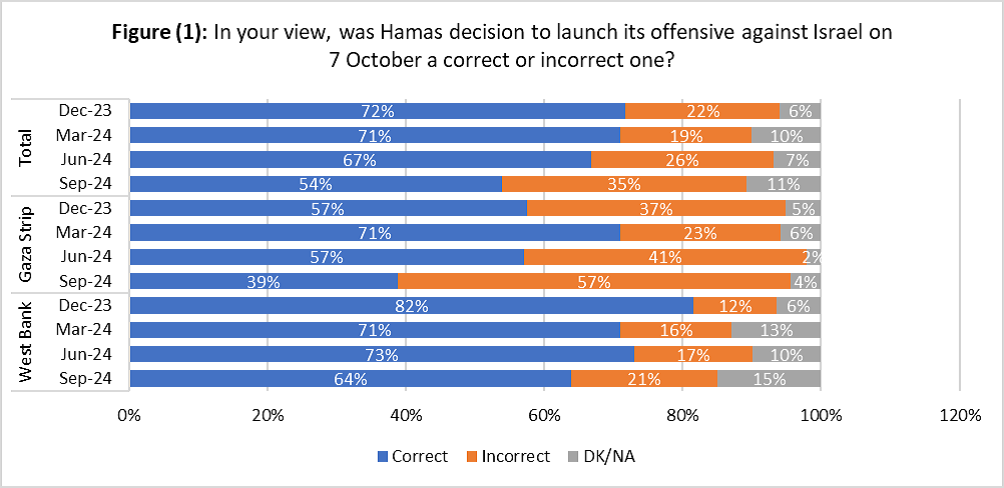
Note. From PCPSR, “Press Release: Public Opinion Poll No. 93,” September 17, 2024.
In the poll by the Independent Opinion Research Strategy, the question was formulated differently and may have been biased to some extent, as it addressed the suffering caused to Palestinians by the blockade of the Gaza Strip. Those surveyed were asked whether they believed that the suffering of Palestinians under the blockade justified Hamas’s actions (the wording was infuriatingly neutral when referring to the violent attack, as reflected in the English translation of the questions that were originally asked in Arabic): Palestinians: “Do you think Palestinian suffering under the siege and blockade of the Gaza Strip justifies what Hamas did on Oct 7?”
The findings indicated 80% supported Hamas’s attacks or saw them as justified, with 52% responding “certainly” and 28% responding “apparently so.” In this poll, the findings regarding this question were not presented separately for the populations of the Gaza Strip and the West Bank.
The survey by Zogby Research Services asked respondents about the extent of the responsibility among different actors for the war. The findings highlight a gap between the three populations: 87% of inhabitants in the Gaza Strip assigned responsibility to Hamas and 85% to Israel (respondents could indicate more than one responsible party), while only 69% of West Bank inhabitants assigned responsibility to Hamas, and 94% assigned responsibility to Israel. In East Jerusalem, 61% of respondents attributed responsibility to Hamas, and, surprisingly, only 84% viewed Israel as responsible despite more extreme views expressed about Israel on other questions.
The AWRAD poll did not include any questions on this topic.
Preferred Government in the Gaza Strip on “the Day After” the War
Views on this subject are more complicated to assess due to the different formulations used in various polls. In Dr. Shikaki’s poll, for instance, participants were asked three different questions: Who do you think will be the victor of the war? How do you assess the extent to which the various actors served Palestinian goals? What is your assessment of the future of the Gaza Strip? Consequently, we can draw conclusions about their assessment of who will govern the Gaza Strip on the day after the war, while other polls asked respondents about their level of trust in, or their assessment of, the quality of governance by the different actors.
Regarding the question, “In your opinion, in this war, who will emerge victorious, Hamas or Israel?,” 50% of all of the respondents in Shikaki’s poll indicated that they believed Hamas would be victorious. However, it should be noted that only 28% of residents in the Gaza Strip supported this view compared to 65% of inhabitants of the West Bank (see Figure 2).
Figure 2.
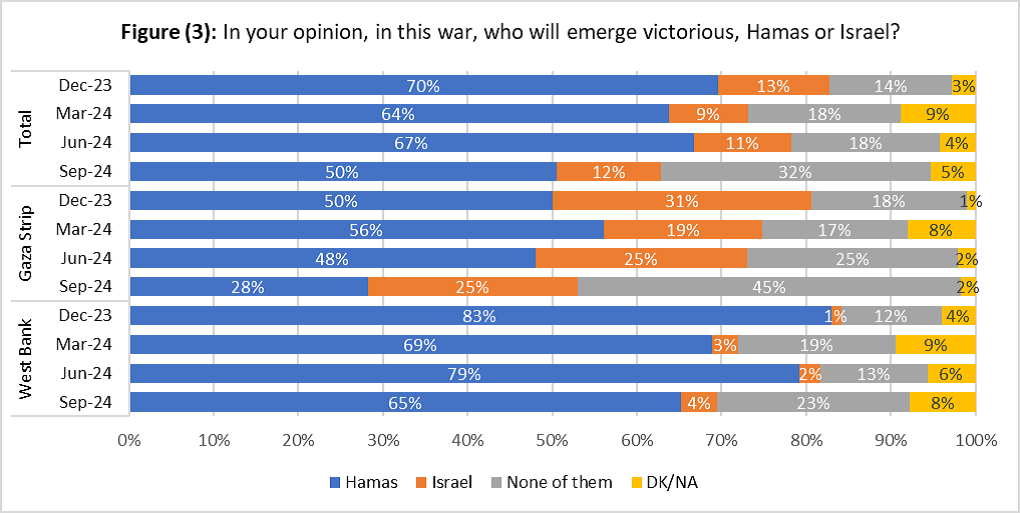
Note. From PCPSR, “Press Release: Public Opinion Poll No. 93,” September 17, 2024.
A similar gap was observed with another question in Dr. Shikaki’s poll, where respondents were asked to assess the future of the Gaza Strip after the war. Of all those polled, 57% stated that they believed the Gaza Strip would remain under Hamas control, although only 37% of residents of the Gaza Strip agreed with this assessment, compared to 70% of West Bank inhabitants.
Regarding the public’s preference, respondents were not asked to express their personal views but rather to assess the public’s preferences. This approach allowed for inferences about their own personal preferences, which they may have preferred not to state openly, instead attributing them to their perception of public preference. In response to this question, 58% of all respondents (73% of West Bank inhabitants and only 36% of Gaza Strip inhabitants) indicated that the public favored the return of Hamas. Only 20% of all the respondents stated that the public would prefer the return of the PA to govern the Gaza Strip.
Examples of public opinion, as assessed by those polled can be seen in the responses to the question regarding the return of the PA under Abu Mazen to govern the Gaza Strip and the Rafah Border Crossing. Seventy percent voiced opposition to this possibility, while 27% supported it. Notably, the percentage of support among Gaza Strip inhabitants—42%—was significantly higher compared to just 17% in the West Bank. Another idea—to insert an Arab security force from Egypt or Jordan in Gaza to assist the Palestinian security forces also lacked support among those polled. Sixty-six percent expressed opposition to this idea, while 32% supported it. Compared to a poll conducted in June 2024 on the same topic, opposition to this idea decreased by 9%, while support increased by 9%.
In contrast to the findings of the PCPSR poll, the AWRAD poll, which examined respondents’ assessments of the likelihood of various outcomes of the war, revealed different perspectives. According to this poll, 21% believed there was a high likelihood, and 47% believed there was a possible likelihood, that the PA would return to govern the Gaza Strip. Additionally, 21% saw a high likelihood, and 51% a possible likelihood, of resuming negotiations for a peace treaty and a two-state solution. Regarding Hamas’s potential return to power, 13% indicated this as highly likely and 21% as a possible likelihood. In addition, 5% indicated a high likelihood, and 28% a possible likelihood, that the war in the Gaza Strip would continue, while 4% believed there was a high likelihood, and 17% a possible likelihood, of an ongoing Israeli occupation of the Gaza Strip.
The AWRAD poll also asked respondents about their level of confidence in the actors who could lead the reconstruction of the Gaza Strip after the war. In response, a significant majority of 63% expressed confidence in the UN, 16% in the Arab states, 7% in the PA, 3% in Palestinian NGOs, and just 1% each in Hamas and the local leadership. In response to a similar question regarding the safest actor to administer humanitarian aid to the Gazan population, 79% expressed confidence in the UN, 5% in the PA, 3% in Palestinian NGOs, 2% in local leaders, and only 1% backed Hamas.
Concerning confidence in Palestinian actors leading the Gaza Strip (it is unclear from the question whether this pertains to the current situation or a post-war context), 40% expressed confidence in the PA, 36% in a Palestinian unity government, 6% in Hamas, 6% in technocrats, and only 3% in local leadership.
The results of the AWRAD poll not only present a contrasting picture with Dr. Shikaki’s findings but also highlight a discrepancy: the high or possible probability that the PA will return to govern the Gaza Strip juxtaposed against the extremely low level of confidence in its capacity to address the Gaza’s challenges.
The Zogby poll posed this question more explicitly: “Which entity would you prefer to govern Gaza immediately after the war?” While only 7% of respondents from the Gaza Strip favored Hamas, in contrast, 38% of respondents from the West Bank and 23% of residents of East Jerusalem supported Hamas (see Figure 3). The possibility of a reformed PA revealed another divide, with 23% of West Bank residents favoring a reformed PA to govern the Gaza Strip, compared to just 9% of Gaza Strip residents. Regarding the prospect of a Palestinian unity government, only 17% of Gaza Strip inhabitants favored this option, versus 34% of West Bank inhabitants. On the question of an administration composed of Gazans, supervised by the UN and linked to the PA in the West Bank, preferences again differed: 29% of Gaza residents favored this possibility, compared to only 11% of West Bank residents.
Figure 3.
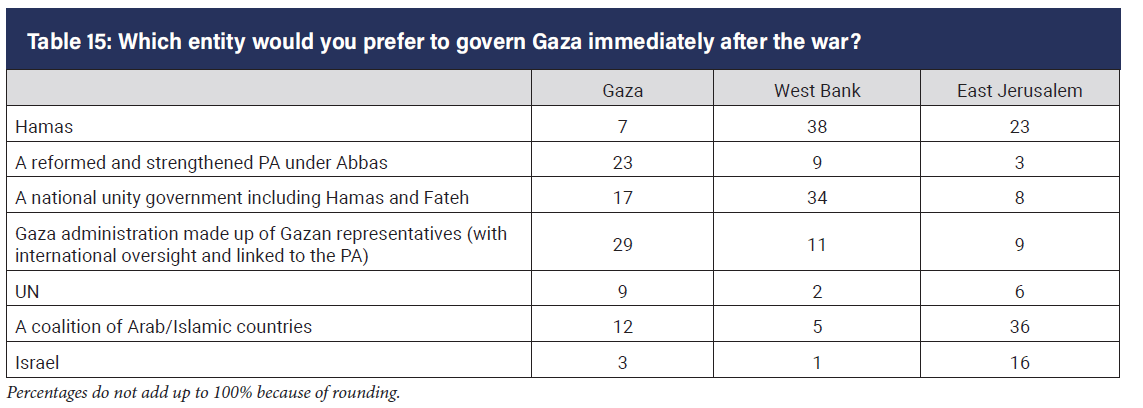
Note. From Zogby Research Services, “Palestine 2024,” Prepared for Tony Blair Institute.
A similar trend emerged from the same poll regarding the question: “Which entity would you prefer to see as responsible for security in the Gaza Strip?” Only 11% of Gaza Strip residents preferred Hamas for this role, while 49% of West Bank residents supported it. Smaller differences were observed between these populations regarding the PA’s security forces under Abbas and a reformed PA without Abbas—24% of Gaza Strip residents favored the former and 29% favored the latter, compared to 19% and 17% of West Bank residents, respectively. There was a more pronounced difference in the preference for the UN as the entity responsible for overall security: 22% of Gaza Strip residents expressed support for this option, compared to just 8% of West Bank residents.
The Level of Support for Continuation of the Armed Struggle
Of the three polls, only the one conducted by Khalil Shikaki explicitly asked about the level of support for the continuation of the armed struggle. The other polls focused primarily on gauging the level of support for a two-state solution through negotiations. Consequently, we are limited to presenting inferences rather than clear findings and will address these related questions in the section discussing views on a two-state solution.
According to the PCPSR poll conducted in September 2024, 48% of the public in the West Bank and Gaza preferred the continuation of armed struggle over other options (see Figure 4). This represents a decrease in support compared to previous polls. Notably, there is a significant gap in the levels of support between residents of the Gaza Strip, where 36% favor this option, and West Bank residents, where support stands at 56%.
Figure 4.
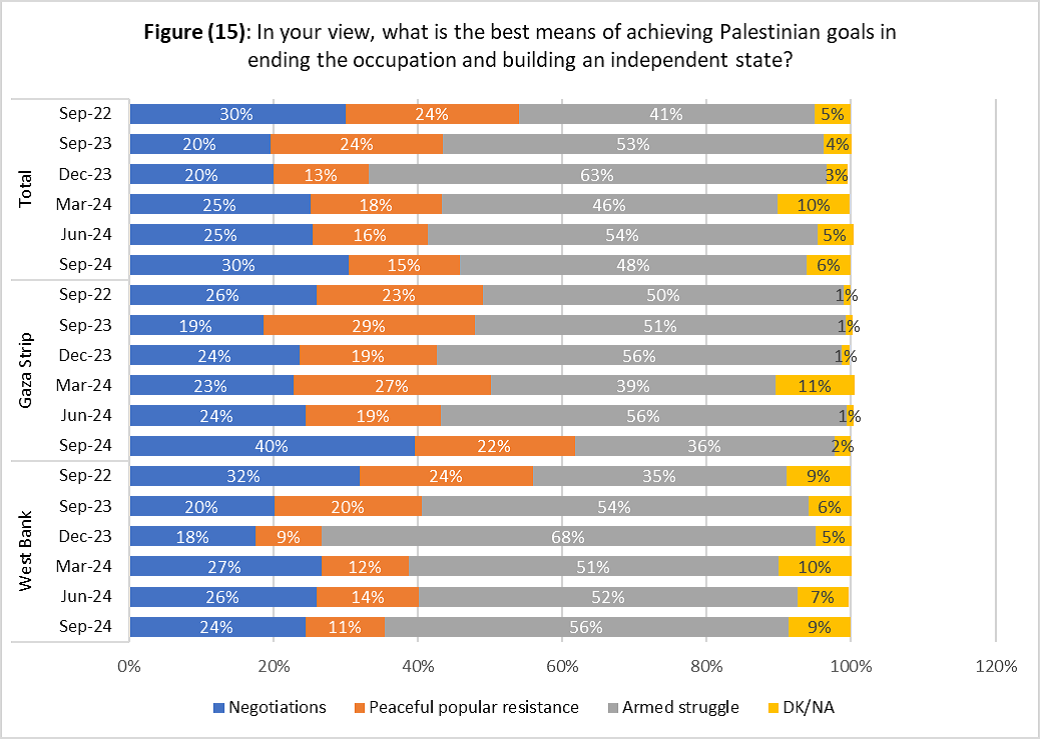
Note. From PCPSR, “Press Release: Public Opinion Poll No. 93,” September 17, 2024.
One significant question asked in the AWRAD poll was “Are developments in the Palestinian arena moving in the right or wrong direction?” Among those polled, 77% believed things were moving in the wrong direction, while only 15% felt they were moving in the right direction. This suggests a perception that the actions of the Palestinian actors—Hamas and the PA—are fundamentally flawed. However, it remains unclear whether this perception stems from a belief that these actors’ efforts were ineffective or that their actions were fundamentally misguided.
Conversely, when asked about their optimism or pessimism regarding the future of Palestine; 41% of respondent indicated optimism, while 57% expressed pessimism.
The Extent of Support for a Two-State Solution
The data on this issue in the AWRAD poll differ significantly from the two other polls. The AWRAD poll, conducted in August 2024, found that 62% of Palestinians support a two-state solution, marking a 15% decrease from the May 2024 poll. Additionally, 19% support a one-state solution, showing a 6% increase compared to May 2024. Furthermore, 37% strongly support negotiations for peace after the war, representing a 23% decrease from the May 2024 poll, while 43% support some level of peace negotiations, reflecting a 19% increase from May 2024.
In contrast, the data of the two other polls presents a completely different picture. For example, the Independent Opinion poll revealed that in July 2024, 40% of Palestinians supported a two-state solution, compared to 21% among Israeli Jews polled (see Figure 5).
Figure 5.
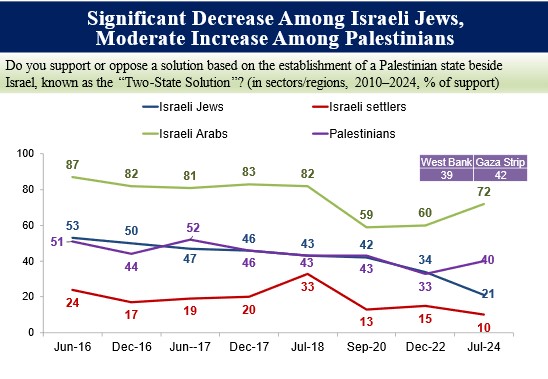
Note. From Independent Opinion Research Strategy, by Dr. Dahlia Scheindlin and Dr. Khalil Shikaki of the PCPSR.
Another question in the Independent Opinion poll of July 2024, posed to both Israeli Jews and Palestinians, examined their level of support for a one-state solution in two forms: a state without equal rights or a democratic state. A single state without equal rights for Palestinians was favored by 42% of Israelis. Conversely, 33% of Palestinians supported a single state without granting full equal rights to Jews (see Figure 6).
Figure 6.
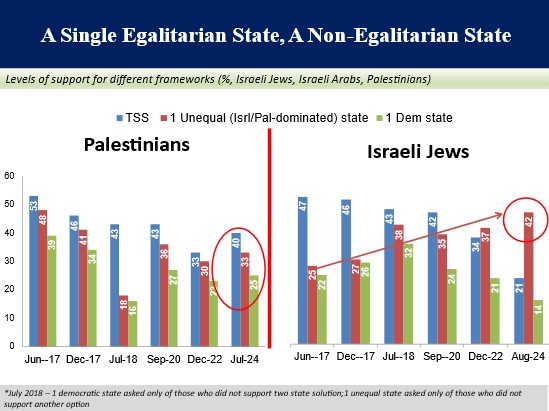
Note. From Independent Opinion Research Strategy, by Dr. Dahlia Scheindlin and Dr. Khalil Shikaki of the PCPSR.
When respondents were asked to assess the likelihood of a two-state solution in practice, nearly identical levels of skepticism emerged from both populations. Sixty-one percent of Palestinians and 63% of Israelis believed that there was no chance of this solution being implemented (see Figure 7).
Figure 7.

Note. From Independent Opinion Research Strategy, by Dr. Dahlia Scheindlin and Dr. Khalil Shikaki of the PCPSR.
In the PCPSR poll of September 2024, 39% of respondents expressed opposition to the two-state solution (see Figure 8). Unlike other questions in the poll, there was a minimal difference between the responses of residents of the Gaza Strip at 39% and those in the West Bank at 38%. It is important to note that we cannot conclude, based on this data, that the remaining 61% of respondents support a two-state solution, as their preferences are distributed among various alternative options.
Figure 8.
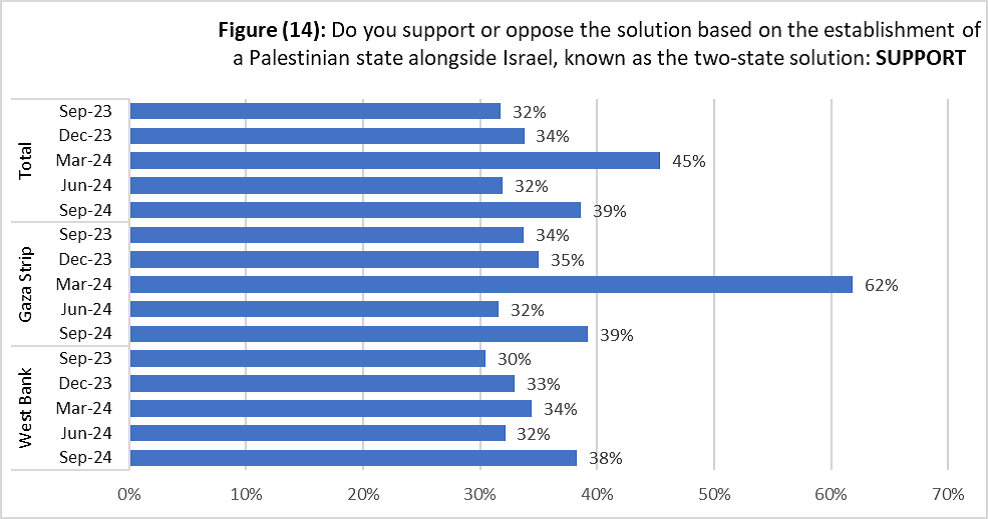
Note. From PCPSR, “Press Release: Public Opinion Poll No. 93,” September 17, 2024.
Views on Support for the Palestinian Authority and Abu Mazen
Polls conducted by Dr. Shikaki in recent years have consistently highlighted widespread dissatisfaction among Palestinians with President Abu Mazen, with a significant portion of respondents supporting his resignation. For example, in the poll from September 2024, 84% of the Palestinian public expressed support for his resignation (see Figure 9).
Figure 9.
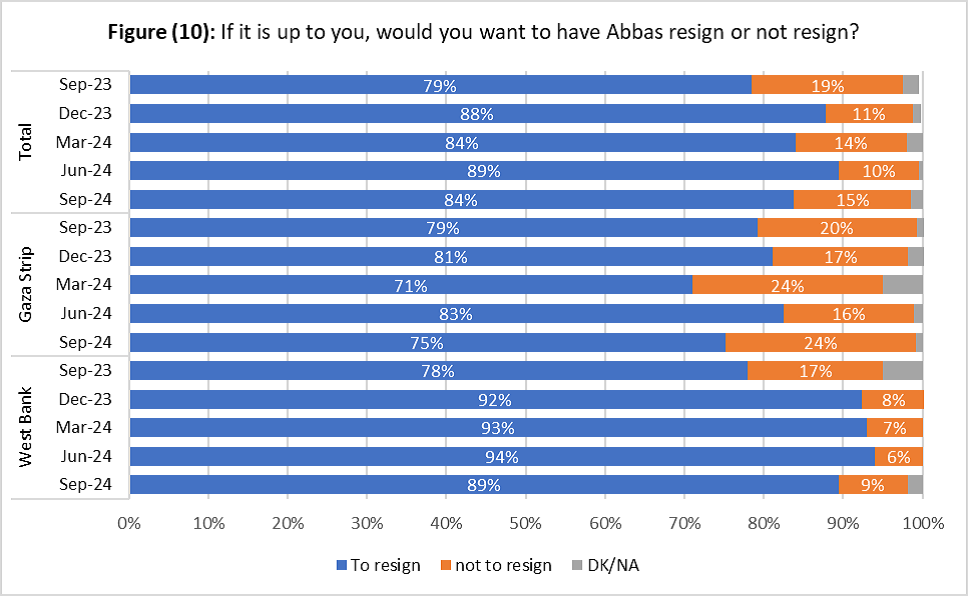
Note. From PCPSR, “Press Release: Public Opinion Poll No. 93,” September 17, 2024.
Dr. Shikaki’s polls reveal a notable trend of stronger support for Hamas compared to Fatah among Palestinians. Unsurprisingly, responses to other questions in the poll revealed that the views of the residents of the Gaza Strip were generally more moderate than those of Palestinians in the West Bank. In the Gaza Strip, 26% of the respondents expressed support for Fatah while 35% supported Hamas. In the West Bank, only 18% supported Fatah, with 37% supporting Hamas (see Figure 10).
Figure 10.
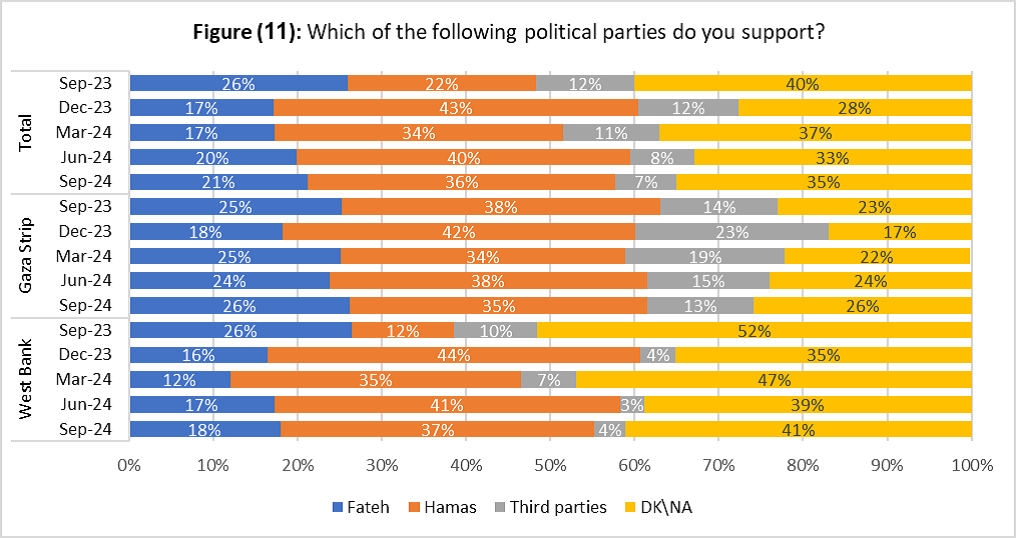
Note. From PCPSR, “Press Release: Public Opinion Poll No. 93,” September 17, 2024.
A similar pattern emerges from responses to the question about which party the population would support if elections were held today (see Figure 11). In the Gaza Strip, 23% would support Fatah, and 29% would support Hamas, while in the West Bank, 14% support Fatah and 30% support Hamas.
Figure 11.
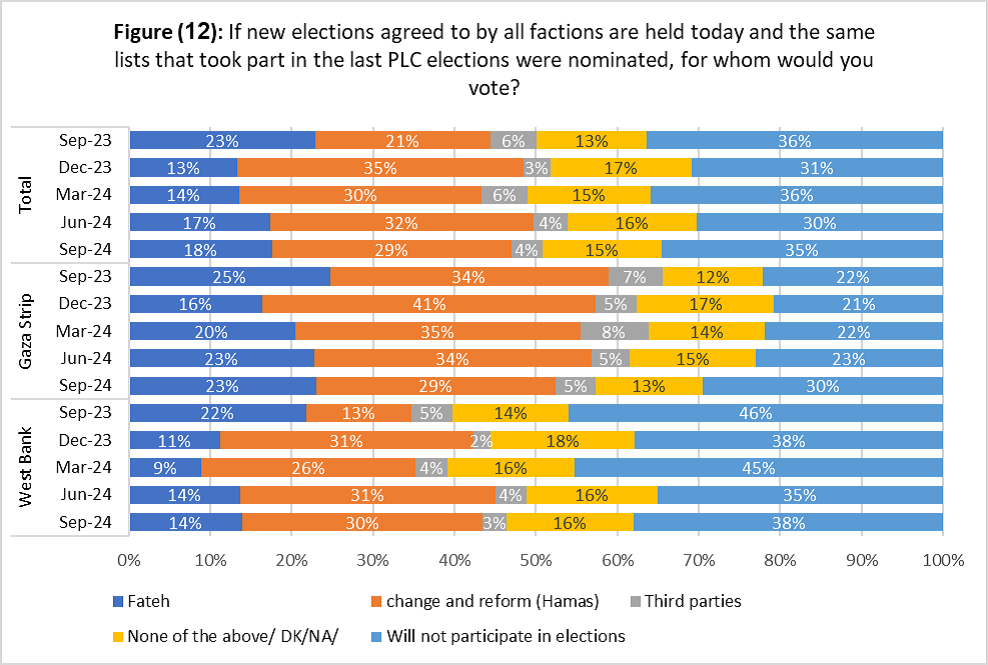
Note. From PCPSR, “Press Release: Public Opinion Poll No. 93,” September 17, 2024.
According to responses regarding the presidential candidate they would choose in an election between Ismail Haniyeh (noting that the poll was conducted before Haniyeh’s elimination in Tehran), Marwan Barghouti, and Abu Mazen, Haniyeh received support from 26% of Gaza Strip inhabitants and 34% of West Bank inhabitants (see Figure 12).
Figure 12.
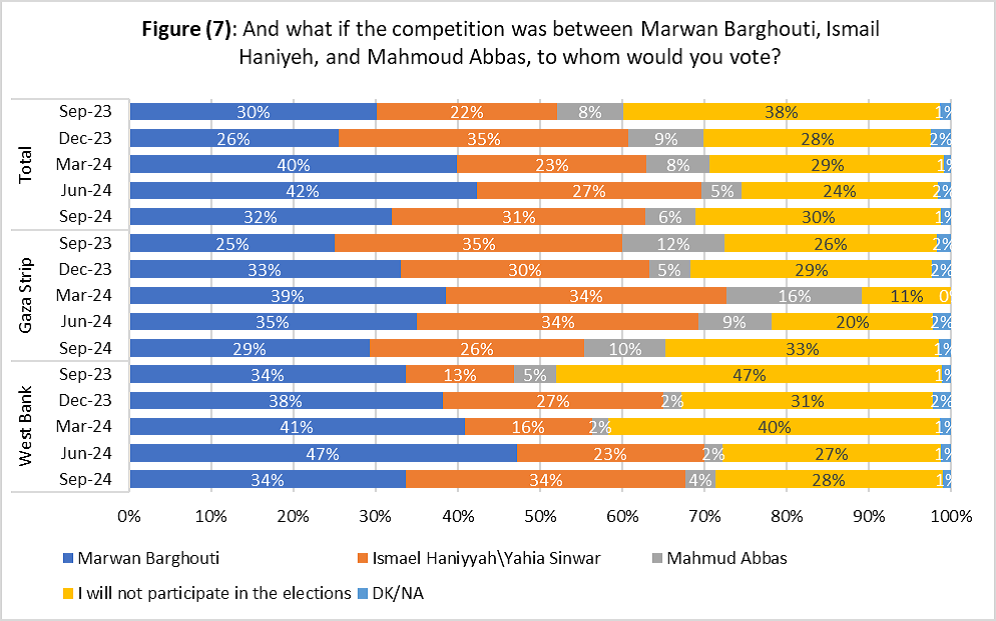
Note. From PCPSR, “Press Release: Public Opinion Poll No. 93,” September 17, 2024.
In the context of a hypothetical presidential elections between Abu Mazen and Ismail Haniyeh, the Abu Mazen is decisively defeated, receiving only 13% support compared to Haniyeh’s 41% among the overall Palestinian public (see Figure 13). The disparity is even more pronounced among West Bank residents, with Abu Mazen garnering just 8% compared to 50% for Haniyeh.
Figure 13.
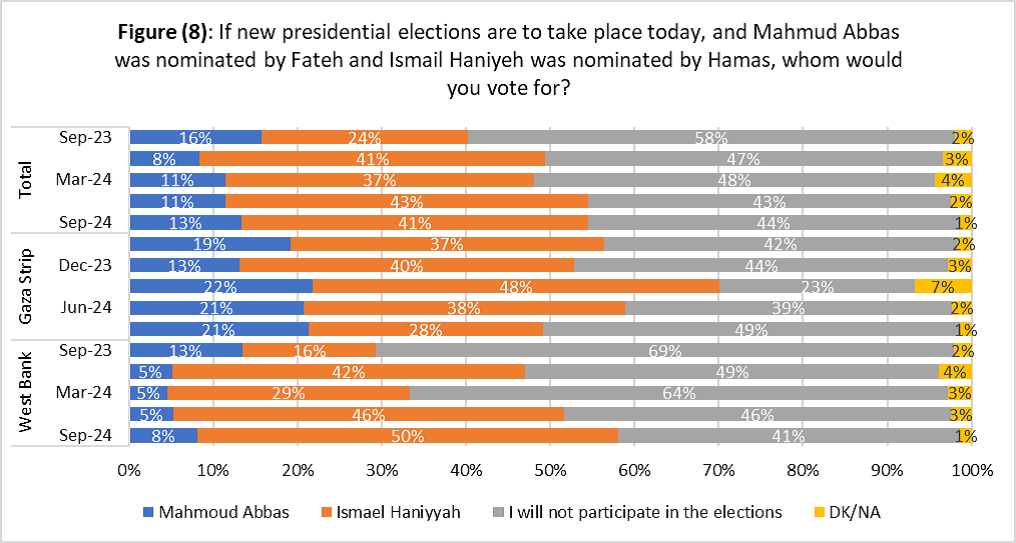
Note. From PCPSR, “Press Release: Public Opinion Poll No. 93,” September 17, 2024.
Regarding satisfaction levels with various Palestinian actors—Hamas, Fatah, Yahya Sinwar, Abu Mazen, and Prime Minister Muhammad Mustafa—there was a notable decrease in satisfaction with Hamas (39%) and Sinwar (29%). In contrast, there was an increase in satisfaction with Abu Mazen (25%), Fatah (29%), and Prime Minister Mustafa (see Figure 14).
Figure 14.
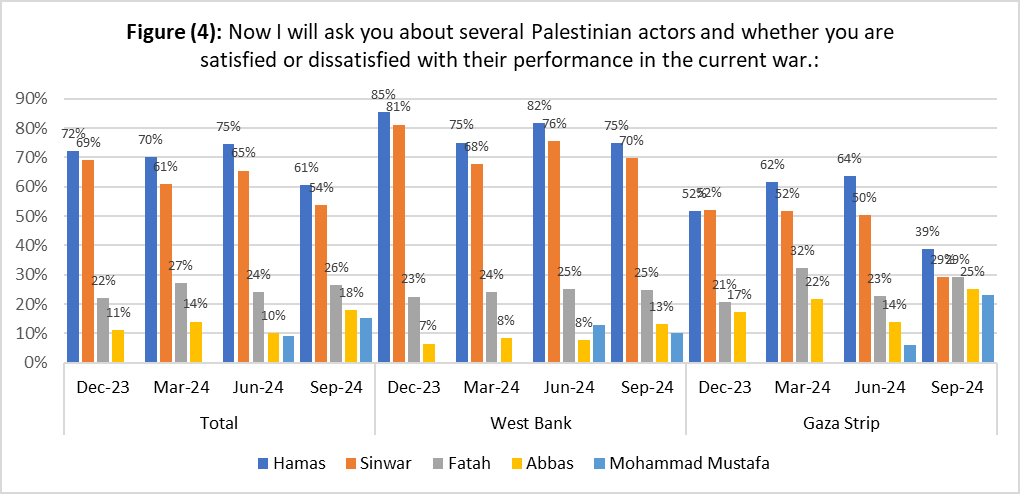
Note. From PCPSR, “Press Release: Public Opinion Poll No. 93,” September 17, 2024.
Analysis and Conclusions
Analyzing poll findings, especially when comparing results across different polls, requires caution due to methodological limitations. Specifically in this case, these limitations include differences in how the polls were conducted, the phrasing of the questions, the selection of a representative sample—particularly those residents of the Gaza Strip in the shelter areas in the southern Gaza Strip, the “halo effect” of the war, and the challenges of systematic and consistent comparisons among the four polls examined in this article.
Comparative analysis of these polls underscores significant differences in the findings on similar questions, notably the criticism of Hamas and dissatisfaction with its performance. There was also decline in the popularity of Yahya Sinwar and Hamas, despite higher levels of support for Hamas compared to Fatah, as well as the assessment that Hamas will emerge victorious from the war with Israel and continue to govern the Gaza Strip. Furthermore, there remains support for the continuation of the armed struggle led by Hamas.
The findings also indicate a clear divergence between the views of Palestinians in the Gaza Strip and those in the West Bank. The Palestinians in the West Bank appears more radical and militant views (the perspectives of the Palestinians in East Jerusalem are even more extreme, but this issue was not thoroughly analyzed in this article due to insufficient poll data). In this context, the Palestinians in the Gaza Strip, having experienced the horrors of war and its disastrous consequences, are more hesitant and perhaps even more realistic than their counterparts in the West Bank, who have not lived through this tragedy. As a result, Palestinians in the Gaza Strip are not only more critical of Hamas but also more supportive of the PA, Fatah, and Abu Mazen.
The decline in support for Hamas’s attack, for the organization itself, and for Yahya Sinwar among residents of Gaza reflects a painful learning process shaped by their firsthand experiences of the consequences of Hamas’s actions. If there is any consolation in this situation, it may lie in the potential for the war’s heavy toll to weaken Hamas’s rule in the Gaza Strip and generate the public support necessary for a civic-government alternative to Hamas. Such an alternative, if established, could provide an opportunity to reverse the dynamics and transform the PA into a new civic-government entity in the Gaza Strip. This entity could serve as a foundation for an independent Palestinian state, differentiated by its effective government and its attributes, in contrast to today’s problematic PA.
From a broader perspective, the poll findings reveal still a strong psychological foundation of support for armed struggle among Palestinians and significant resistance to a two-state solution. Similarly, a similar level of support for a two-state solution can be observed within the Israeli public. This suggests that the two-state paradigm has lost its viability in the current context, and it is doubtful whether it will regain legitimacy in the foreseeable future—unless a fundamental change occurs in the situation and sentiments of both societies.



